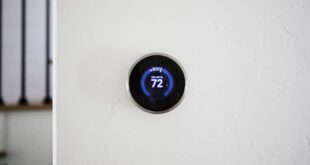TOP 5 HOME ENERGY- AND MONEY-SAVINGS TIPS HIGHLIGHTED BY NON-PROFIT RENEWABLE NATION
Nearly $100 a Month in Savings Possible in Most Homes By Following Simple Steps; Renewable Nation App Promotes More Solar Homes, Also “Curates” Best Energy-Saving Tips.
WASHINGTON, D.C. – November 19, 2018 – If you are one of the millions of American homeowners who is contemplating going solar, the good news is that you can save up to $100 a month in the meantime by acting on some basic energy-savings tips, according to the nonprofit Renewable Nation app available now on Google and iTunes.
Renewable Nation is an independent non-profit effort dedicated to accelerating the adoption of safe, affordable and clean energy in U.S. homes and schools. Additional information about the app-based effort is available at www.RenewableNation.us.
Scott Stapf, program director, Renewable Nation said: “Getting more homeowners to go solar is our number one priority and we know that the best way to get that process started is to help people feel more connected to energy in their home and how to save money by using less of it. What we have done here is curate the best available tips so that homeowners can feel more empowered about taking charge of their energy use around the house.”
Americans spend $350 billion a year on electricity – that works out to about $2,100 per household. It is estimated that no less than three-quarters of home energy use goes to waste. While it’s not possible to recover all of that lost energy, experts believe that nearly $100 a month can be saved in the typical home, even short of taking such major steps of replacing windows and extensive insulation.
As featured on the Renewable Nation app, the “Top Renewable Nation Tips for Saving Money and Energy Around the House” are as follows:
- Get audited. To get the full picture of your energy waste and potential savings, a home energy audit conducted by a qualified expert is an excellent place to start. Who can you trust? Two places to go are the Building Performance Institute (www.bpi.org/about-us/faqs) and the Residential Energy Services Network (www.resnet.us/directory/
search). While you are waiting on your audit, you can bone up on home energy use and savings by reading the ENERGY STAR publication, “Tips on Saving Money and Energy in Your Home” (https://www.energy.gov/sites/ prod/files/2017/10/f37/Energy_ Saver_Guide-2017-en.pdf). - Plug your leaks. According to Consumer Reports: “You can do some air-sealing tasks yourself such as plugging leaks around windows, doors, and electrical outlets with caulk, expandable sealant, and weather stripping. Insulating and sealing ductwork, found in homes with forced-air heating and cooling, is best left to the pros, but it could lower your energy bills by about $400 a year. And rebates can save you more on the cost of the job; go to dsireusa.org for details” (https://www.consumerreports.
org/cro/magazine/2013/10/ bright-ideas-that-save-energy- and-money/index.htm). - Check out your water heater. Heating water is typically the second largest energy use in a home. It can cost $600 or more a year, and you can save $300-$350 of that. A hybrid water heater – which combines a standard water heater with a heat pump — can pay for its extra cost in two years (https://www.youtube.com/
watch?v=uyn5RPqSPic). A related recommendation: Wash your clothes in cold water to save $63 a year because new laundry detergents are designed to work in cold water (https://www.ase.org/ resources/top-10-home-energy- efficiency-tips). - Get a smart thermostat. You can save up to 10 percent each year on heating and cooling bills by turning down the thermostat 7°-10°F for eight hours a day. According to the U.S. Department of Energy, space heating is typically the largest energy expense in the average American home, responsible for nearly 45 percent of residential energy bills. On average, a programmable thermostat can save you $180 per year (https://www.neefusa.org/
weather-and-climate/weather/ fall-energy-savings). - Avoid the “phantom” menace. Energy Sage has this advice: “’Phantom loads,’ or the electricity used by electronics when they are turned off or in standby mode, are a major source of energy waste. In fact, it is estimated that 75 percent of the energy used to power household electronics is consumed when they are switched off, which can cost you up to $200 per year. Smart power strips, also known as advanced power strips, eliminate the problem of phantom loads by shutting off the power to electronics when they are not in use” (https://www.energysage.
com/energy-efficiency/101/ ways-to-save-energy/).
Here are three bonus tips from Renewable Nation that you also should consider:
- Size up your fridge. The American Council for an Energy-Efficient Economy has this advice: “If your current refrigerator or freezer is more than 15 years old, it may be so inefficient that a new one would pay for itself in energy savings in just a few years … A typical new refrigerator uses less than 450 kWh per year — less than one-quarter the energy of a typical 1973 model — even though today’s model is larger and has more features” (https://
smarterhouse.org/appliances- energy/food-storage). - Lighten up your lighting. Replace your home’s five most frequently used light fixtures or bulbs with Energy Star models to save $75 per year. Halogen incandescent bulbs, compact fluorescent lights (CFLs), and light-emitting diode bulbs (LEDs) use anywhere from 25-80 percent less electricity and last three to 25 times longer than traditional bulbs(https://www.energysage.com/
energy-efficiency/101/ways-to- save-energy/). - Shop smarter. Look for the Energy Star label, the government’s symbol of energy efficiency, on a wide range of consumer products to save up to 30 percent on related electricity bills (www.energy.gov/energysaver/
energy-saver). When you buy, use the best shopping-aid tools out there, such as Enervee (https://choose.enervee.com/). It shows current sales price by household item, where the quoted prices are honored, price drops of items that you have saved, and more.
 Alternative Energy HQ solar power for homes, wind energy, and bio fuel issues
Alternative Energy HQ solar power for homes, wind energy, and bio fuel issues







One comment
Pingback: TOP 5 HOME ENERGY- AND MONEY-SAVINGS TIPS